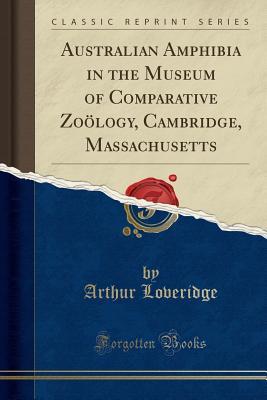Read Australian Amphibia in the Museum of Comparative Zo�logy, Cambridge, Massachusetts (Classic Reprint) - Arthur Loveridge | PDF
Related searches:
Amphibians and Reptiles - The Australian Museum
Australian Amphibia in the Museum of Comparative Zo�logy, Cambridge, Massachusetts (Classic Reprint)
Australia's native frogs - The Australian Museum
An annotated list of reptiles and amphibians from the 1905 Hamburg
Type specimens of amphibians in the National Museum of Natural
Frogs: Class Amphibia - The Australian Museum
Herpetology - The Australian Museum
The history of amphibian declines in - The Australian Museum
Type specimens of reptiles and amphibians in the Australian
Tasmanian amphibia in the museum of comparative zoology
Zoosporic parasites of amphibians. - The Australian Museum
Amphibian Species of the World - American Museum of Natural History
A Catalogue of the Non-fossil - The Australian Museum
Conservation status of the reptiles - The Australian Museum
An annotated type catalogue of the frogs (Amphibia: Anura
The Triassic amphibian Thoosuchus - The Australian Museum
The amphibia of the Indo-Australian archipelago : Kampen
The Amphibia of Tasmania SpringerLink
The balance between egg and clutch size among Australian
The cane toad: a new host for helminth parasites in Australia
1923 - The amphibia of the Indo-Australian archipelago
Michael James Tyler, AO (1937–2020): Specialist on the Frogs
Desert lizardsaustralian desertcrocodilesreptiles and amphibiansbritish museumwestern australiahabitatsinspirationbiblical inspiration.
Since the establishment of the western australian museum (wam) in 1891, its natural history collection has grown substantially to become one of the largest collections in australia, and one of the largest regional collections in the world. Amphibian specimens make up about 29,000 of the 160,000 specimens in the herpetological collection.
Other affiliations: add research interests: ecology, conservation biology, biodiversity, zoology, herpetology, southeast asia, and 3 moreamphibians,.
Frog eggs are mainly laid in water and their larval stage as tadpoles have.
1912 (digenea: telorchiidae) from the introduced toad bufo marinus.
The museum started to collect specimens over 150 years ago and focuses on south australian and australian fauna, although neighbouring lands such as antarctica and new guinea are also well represented. Specimens collected include terrestrial and aquatic invertebrates, parasitic worms, amphibians, fish, birds, reptiles and mammals.
The mission of the australian amphibian and reptile genomics (ausarg) initiative is to build genomic resources to understand and protect australia's reptiles.
Bass strait, which presently isolates tasmania from the adjacent australian mainland, has acted as a land bridge during the lower sea levels of pleistocene glaciations (littlejohn, 1967). Thus there has been opportunity for repeated migrations and subsequent differentiation of isolated populations ( littlejohn� 1967).
The following catalogue lists, for the first time, the primary and supplementary type specimens of amphibians and reptiles in the australian museum. It seems desirable to record, from time to time in a museum's history, the status of type collections on which a great deal of taxonomic research is ultimately based.
Australia, new zealand, and pacific islands aims to stimulate research into halting amphibian declines and to improve decisions about conservation.
The australian museum herpetology collection contains specimens of most known australian species of amphibian and reptile. Although constantly growing, the size of the collection is over 200,000 specimens, including almost 700 primary type (species reference) specimens, of which nearly 100 percent have been digitised.
*will not find nomina inquirenda; use basic search (above) for that purpose.
Amphibians crawled from the water over 370 million years ago and were the first vertebrates to colonise the land. Australia has around 200 species of native amphibians, all of which are frogs, belonging to the order anura.
The australian museum has a large and comprehensive collection of research specimens from throughout australia and the pacific region.
The amphibia of the indo-australian archipelago by kampen, pieter nicolaas van, 1878-1937. American museum of natural history library language english volume 1923.
Amphibians of australia are limited to members of the order anura, commonly known as frogs. All australian frogs are in the suborder neobatrachia, also known as the modern frogs, which make up the largest proportion of extant frog species.
The australian museum respects and acknowledges the gadigal people of the eora nation as the first peoples and traditional custodians of the land and waterways on which the museum stands. This website may contain names, images and voices of deceased aboriginal and torres strait islander peoples.
I have a lifelong passion for invertebrates and amphibians and have worked at ian potter australian wildlife biobank i managed the tissue and dna collection,.
Reptiles and amphibians of australia - kindle edition by cogger, harold. Download it once and read it on your kindle device, pc, phones or tablets.
Santiago castroviejo-fisher american museum of natural history, new york, usa editor australian museum, sydney.
The australian museum is helping scientists learn more about endangered frog species so they can better safeguard the amphibians and their habitats.
A review of amphibian taxonomy placed bufo marinus in the chaunus long ( australian museum 2003; canetoadsinoz.
Frog eggs are mainly laid in water and their larval stage as tadpoles have developed tails and internal gills adapted to life underwater.
Country distribution from amphibiaweb's database: australia.
The australian museum respects and acknowledges the gadigal people of the eora nation as the first peoples and traditional custodians of the land and waterways on which the museum stands. Image credit: gadigal yilimung (shield) made by uncle charles chicka madden.
The triassic amphibian thoosuchus yakovlevi and the relationships of the trematosauroidea (temnospondyli: stereospondyli) - the australian museum this website uses cookies to ensure you get the best experience on our website.
Registration of reptile and amphibian specimens in the herpetology collection began in 1911. The collections include some old samples from the early days of the museum but the herpetology collection was a small one until the last third of the 20th century when research into reptile and amphibian diversity greatly intensified.
The helminth fauna of native australian amphibians and the introduced toad, bufo marinus was studied.

Post Your Comments: